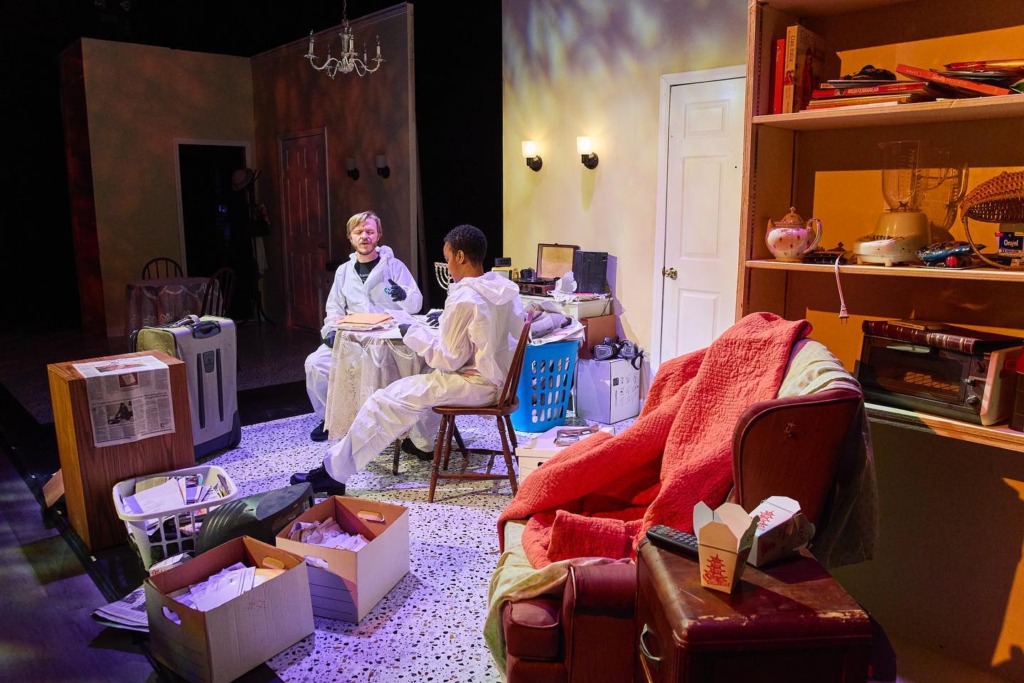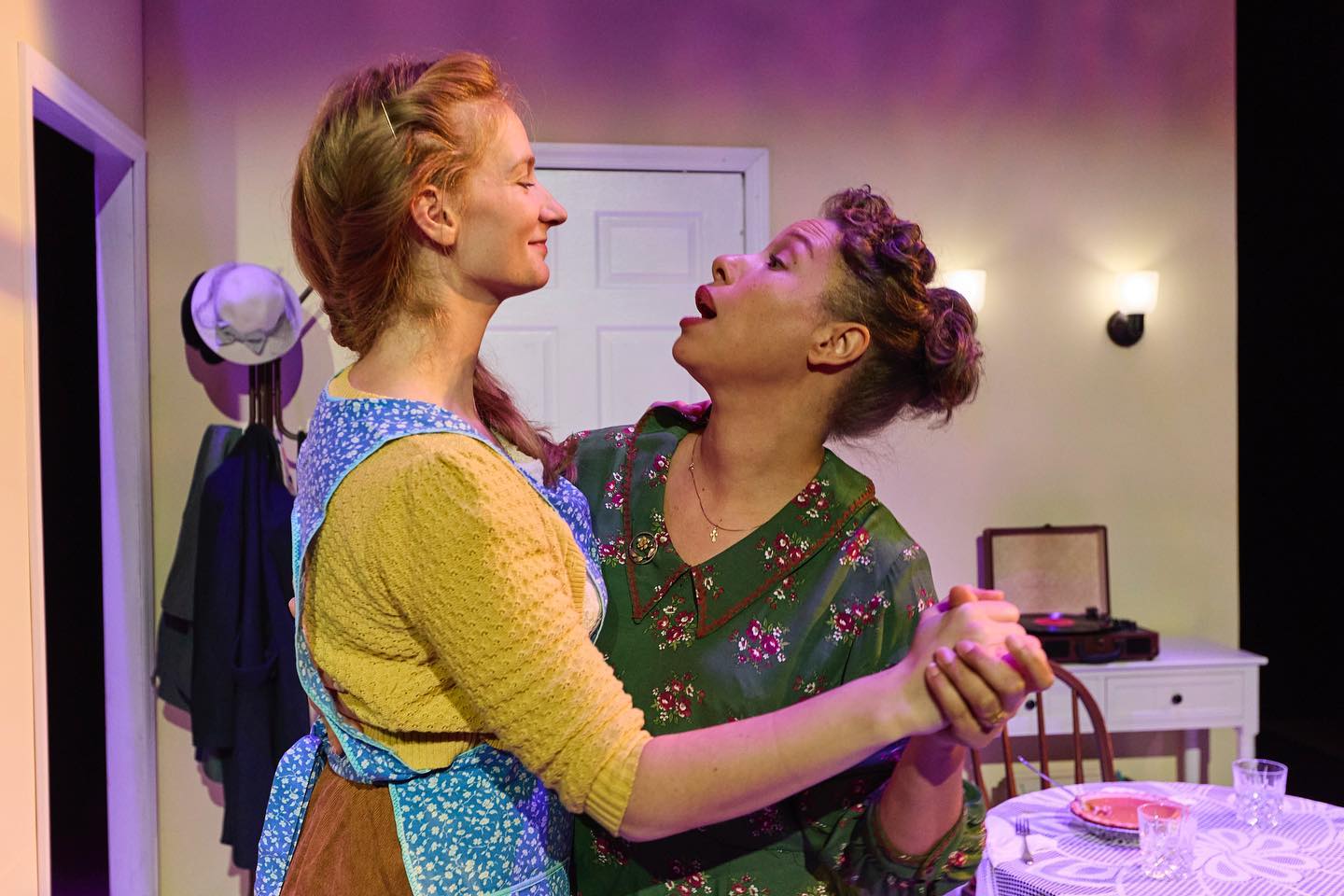Beth Kander’s play opens in present century Chicago, circa 2015, when the death of an elderly hoarder brings two county employees, Cassie and Hal, to her (rent-free) apartment to help verify her actual identity. As the employees search through documents and belongings to find clues to her identity, the play offers flashbacks to 1955, where we meet two war widows: Esther, the Jewish inhabitant of the once-pristine apartment and Lynley, her Black neighbor from Alabama, who strike up an unlikely friendship. The play proceeds to move back and forth between the past and present, unfolding the story of the apartment and its inhabitants, while the county employees continue to search through documents and share secrets about their own lives.

In Perisphere’s production, directed by Lizzi Albert, the scenes from 1955 seemed consistently engaging and rewarding, due in no small part to the naturalistic performances of Kullen Edberg and Dawn Thomas Reidy as Esther and Lynley. They handle the language with ease and create a very believable rapport. Indeed, Reidy’s Lynley sparks up the play and gains audience appreciation and laughter from her first entrance, etching a warm and believable portrait of a woman both at home, and alone, in the Windy City, and determined to make a friend. Edberg’s performance as Esther warms up more slowly, passing through politeness and reserve to easy camaraderie and then bravery. Inevitably, as their friendship builds, we hear confessions of the lives they have left behind: Lynley’s determination to escape the endemic racism of 1950’s Alabama, and Esther’s guilt-laden move from Europe to America leaving her family behind to the Holocaust; as well as the similar deaths of their young husbands in the war. Both actors handle their emotional monologues adroitly, especially in the scenes revealing the final challenge to their friendship, but it is the believability of the actors’ warm and sunny connection that genuinely sustain the flashback scenes.
Unfortunately, that rhythm is not sustained in the scenes set in the present with the county employees Cassie (Jessica Ludd) and Hal (Seth Rosenke.) While Jessica Ludd as Cassie has some wonderful moments conveying her inner struggles, and both actors find a chance to earn some laughs, their scenes are often frustratingly slow in pace. We learn that both characters are troubled, yet while there is a similarity in that two people of disparate backgrounds and races seem able (slowly) to connect and make a new start as possible friends, the inclusion of these confessional scenes between the colleagues do not seem to complement, reinforce or better illuminate the unfolding story of Esther and Lynley– they just take time, and keep us from returning to the scenes from the past.

In those scenes, we learn that the challenge to Esther and Lynley’s friendship is the “love that dares not speak its name” in 1955 Chicago. Esther makes her feelings known, but Lynley cannot reciprocate, and plot decisions reveal which woman was still alone in the apartment, decades later. At play’s end, specific details are not explicitly learned, but we can draw inferences about what has happened in the ensuing decades, infer character reasons for hiding and hoarding, and even infer that both women may have died within days of each other. The inferences that we can make, and the earlier dialogue clues that prompt them, are haunting, yet all of this remains disjointed from the scenes set in the present, where the employees discover nothing of the truth revealed in the flashbacks. Perhaps that is one point of the piece: that we can never know the full truth of others’ lives and that much of what we deduce about others is based on imperfect knowledge.
The scenic design by Jessica Trememtozzi was fine, if uninspired. We infer that the two sides of the stage are the same apartment in a crazed mirror image. Was I struck that one was an apartment in a bad Chicago neighborhood in 1955 and the other was the same apartment 60 years later and owned by a hoarder? No, not really. Costumes by Jessica Utz were effective and did more to relate the decades than the set. The sound design by Cheryl Williams helped us to connect to the decades but was a bit overhanded again with the unnecessary scene changes. The lighting design by Haily LaRoe was effective in making a stark set look less sterile and slightly warmer.
Overall, we believe that there is strong acting and a strong script in Hazardous Materials, but that the show could have run about 15 minutes shorter. Aside from the acting choices made in the modern section (with too many unearned pauses), the changes of scenes could have been (and perhaps should have been) seamless, flowing easily from the past to the present and back again, but the belabored use of scene change music and needless running crew changes slowed the show to a snail’s pace far too often.
The theme of women whose lives cannot be fully embodied or accepted within the sexual and racial mores of their era do not find suitable response or completion in the scenes of the present, but perhaps that is the point.
Running Time: Approximately 2 hours and 15 minutes with one intermission
Hazardous Materials plays through November 18th 2023 with Perisphere Theater at The Writer’s Center— 408 Walsh Street in Bethesda, MD. Tickets are available at the door or in advance online.

